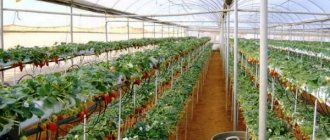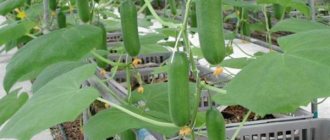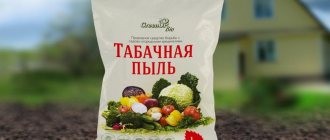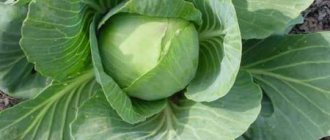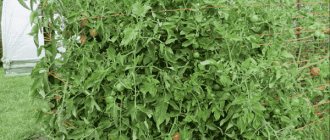Choosing a variety or hybrid for greenhouse cultivation
There are special varieties of crops that are ideal for growing in greenhouses. Such conditions allow you to harvest the crop as quickly as possible, even in regions with a harsh climate.
Bibo F1
The fruits of the Dutch selection are distinguished by their white color and good taste. The culture has excellent resistance to viruses, in particular the common fusarium. There are a large number of ovaries on meter-long bushes. The fruits themselves are oval-shaped, the average weight is from 250 to 500 grams.
Boyarin F1
Another early-ripening hybrid with a classic form. One of the advantages is high resistance to temperature swings, but this variety needs pinching. The weight of an average eggplant reaches 450 g.
Alyonka
An excellent early ripening representative with good taste. When grown properly, eggplants in a greenhouse can grow up to 350 grams. From an area of 1 sq. m. harvest up to 7.5 kg of vegetables.
Goliath F1
An excellent variety of eggplants; when planted and cared for in a greenhouse, you can grow up to 9 kg of vegetables from a 1 square meter bed. meter. The weight of one ripe fruit reaches 1 kg.
The Goliath variety is distinguished by unusual pear-shaped fruits
Pink flamingo
The elongated purple fruits grow up to 450 g. The bushes need staking. The variety is not whimsical and is suitable for growing in polycarbonate greenhouses.
Joker
Tall, ultra-early ripening crop. The small mass of fruits (up to 130 g) is compensated by their quantity. Up to one hundred ovaries appear on one bush.
Swan
The cylindrical, slightly elongated white fruits reach 250 g with proper care. Ripening occurs on the 100th day. A variety with good frost resistance.
Viola di Firenze
A good high-yielding variety, bred by Italian breeders. The oval fruits are famous for their weight: each eggplant grows up to 750 grams. The big minus is instability to temperature changes.
Maxik F1
The variety belongs to early-ripening and medium-growing representatives; ripening occurs 90 days after sowing the seeds. Maksik is famous for its good immunity, tolerates temperature changes well, and shows resistance to a number of diseases. Purple vegetables grow up to 25 cm, weight −250 g.
Eggplants of the Maxik variety are valued because they lack the bitterness characteristic of vegetables
Planting eggplants in closed ground
The hardening procedure before transferring it to the greenhouse may consist of ventilating the room and removing the seedlings to the greenhouse during the day. Even if in the future eggplants do not have to face the negative influence of the external environment, the stronger the seedlings are, the more harvest they will produce.
How to prepare the soil for planting eggplants
The composition of the soil should correspond to the needs of the blue ones - loose, slightly acidic, fertile. The earth has been preparing since autumn:
- the first stage is thorough cleaning and disinfection of the greenhouse;
- if time permits, after harvesting, the land is sown with green manure, which is later dug up;
- in the spring the digging procedure is repeated;
- apply mineral fertilizers;
- The timing of planting eggplant allows you to collect an early harvest of greens or radishes in this place - this will only benefit the blue ones.
The timing of planting depends on weather conditions, the type of greenhouse and the ripening time of a particular type of eggplant. Transshipment into the ground is indicated for seedling bushes that have the first peduncle.
How to plant seedlings in a greenhouse
Any manipulations with seedlings that injure the root system slow down its development and increase the risk of infection with fungal diseases. What’s good about growing in peat containers is that it allows you to lower the root into the hole without exposing it.
To do this, recesses are dug in the greenhouse bed, slightly larger in depth than the dimensions of the pot. The eggplant is placed in the hole without deepening it. If the pots look very strong, you can cut the bottom and walls in several places with a knife. This will make it easier for the root system to cope with the peat walls that limit it.
The soil in the hole is watered before and after planting, sprinkled with a layer of mulch on top and left without watering for three to four days.
After transplantation, the air temperature in the greenhouse must be maintained within 20-22 C.
At what distance to plant eggplants in a greenhouse (planting patterns)
The landing method can be chosen linear - in one groove at equal intervals from each other. Or chess - in the holes.
The distance between the rows must be maintained at about 60 centimeters. And 30–35 centimeters in the row between plants. In heated greenhouses, planting density should be no more than 2 bushes per square meter. In unheated greenhouses, 3-4 bushes are the optimal number of plants per square meter.
The main rule of a greenhouse is that plants are planted according to their height. Tall two-meter eggplants can be placed in the center. Plants that are inferior to them in growth should be planted as their height decreases.
Preparing the greenhouse before planting eggplants
Before planting, you need to take care of safety. First of all, all vegetation is destroyed, since the pest can overwinter in it. Disinfection is required; the easiest way is to spray the structure with bleach. In a wooden greenhouse you can use a sulfur bomb.
Before cultivating the soil, it must be dug up. The disinfection process itself is carried out in two ways:
- in the first, it is supposed to disinfect the substrate with dry bleach; it is simply sprinkled on top;
- the second option is spraying with formaldehyde, after which the beds are covered with plastic wrap and left for a day.
Note! There is also heat treatment, but it will require special equipment that supplies steam.
Stage #1 – preparing the soil for planting
So, you need to prepare the soil for planting eggplants in the fall: the plant remains of previous crops are removed, and the soil is thoroughly watered twice with water so that even excess fertilizer is washed away. After which the soil must also be disinfected from various diseases with a solution of copper sulfate, taking 2 tbsp. spoons per 10 liters of hot water. And finally, as soon as the soil dries, it should be completely dug up to the depth of a spade bayonet, or, in extreme cases, just loosened well. But, if the greenhouse is without a roof for the winter, then there is no need to break up the clods of earth when digging - this way sediment will accumulate in it, and the existing pests will die. But in the spring you will only need to dig up warm loamy soil - everything else can just be loosened, and that’s it.
Eggplants love organic fertilizers. So, for one square meter you need to take from half to three-quarters of a bucket of manure or compost humus, sprinkling the soil with dolomite flour to reduce acidity (2 tablespoons per 1 sq.m). By the way, this flour also contains magnesium, which eggplants desperately need.
Half a bucket of low-lying brown peat, which will retain moisture well, will also be beneficial. But in order for the soil to be loose, it is advisable to add one glass of old sawdust. 1 cup of ash and 1 tablespoon of potassium sulfate will not interfere with the soil for eggplants.
And you need to apply fertilizers like this: the area of the bed is measured, the amount of fertilizer required for it is prepared, everything is evenly scattered over the surface of the soil and carefully dug up. True, if the greenhouse is large and there is little fertilizer, then you can add it directly to the hole of the plant, providing complete fertilizing already during the growing season. But this method is, of course, worse.
Features of caring for eggplants in a greenhouse
The quantity and quality of the harvest depends on the care of vegetable crops. Eggplants, like other vegetables, need care and regular maintenance.
Watering: volumes, methods, timing
For active growth and fruiting, it is important to provide eggplants with regular watering. There are several rules for the procedure:
- water for irrigation should be warm and settled;
- vegetables prefer the root method of moistening; liquid should not be allowed to get on the green mass;
- events are held in the first half of the day.
Lighting and temperature conditions
For normal growth and fruiting, eggplants require good lighting. Daylight hours should not be less than 12 hours. Otherwise, the plant bears fruit worse, and all its energy goes into growing green mass.
Planting eggplant seedlings
Eggplant seedlings
How to grow eggplants in a greenhouse? It all starts with planting seeds and nurturing seedlings. For this you will need:
- Cut plastic bottles, 8 cm in volume, or peat cups, which are designed specifically for such purposes.
- The soil is cleaned and mixed with sawdust. This allows the soil to constantly be fluffy and freely accept moisture and air, which are so necessary for the normal development of the root system of seedlings.
- Water and a wooden stick for making a hole in the center of a cup or plastic bottle.
Advice. Before planting, it is best to neutralize the seeds with a solution of potassium permanganate and soak them in plain warm water for a day.
- Using a stick, holes are made in the container and the seeds are placed in them. from above they are crushed with soil and watered.
- How to grow eggplants in a greenhouse? As soon as the seedlings have one leaf, you will need to fertilize the soil with organic means. The last stage of feeding is carried out several days before planting the seedlings.
Advice. Before planting, you should not water the eggplant seedlings, since the soil in the greenhouse is also moistened and thus there may be an excess of moisture, which is harmful to the root system of these vegetables.
Control of diseases and pests in the greenhouse
Gardeners most often encounter diseases in the form of late blight, rot and tobacco mosaic when growing eggplants. Fungicides will help get rid of them.
As for pests, eggplants most often suffer from aphids, spider mites and mucus. Biological preparations are used against them; Strela has a good effect.
Important! Prevention of diseases and pests involves timely disinfection of the greenhouse structure and garden tools. The vegetation itself is also processed.
↑ Preparing greenhouse structures before sowing or planting eggplants
Before spring planting begins, greenhouses and greenhouses must be disinfected. And not only surfaces, but also soil and tools. Otherwise, there is a risk of causing harm to new plantings.
↑ Putting things in order and disinfecting
The first thing to do in the greenhouse is cleaning: the weeds that appear are pulled out and thrown away, the equipment is washed and disinfected after winter.
- Glass surfaces and film are washed with soapy water. It is better to wash metal parts with a hot vinegar solution. Polycarbonate is cleaned with a manganese solution. After washing, the greenhouse is opened and dried.
- Disinfection. There are several ways.
- Sulfur checker. The sulfur that the checker produces envelops every crack in the greenhouse. After treatment, the building is tightly closed for three days. Then be sure to ventilate. The method is used only for wooden frames.
- Bleaching powder. Everything in the greenhouse is sprayed with a bleach solution: walls, ceiling, soil, equipment.
- Biological products for disinfection. The solutions are safer, but their effectiveness is lower than that of bleach or sulfur. The use of biological products will increase the nutritional value of the soil and destroy pathogens.
↑ Soil treatment
Before planting, the soil in the greenhouse or greenhouse must be prepared. If bushes of plants remain in the fall, they are removed. The soil must be dug up, while at the same time selecting the roots of the weeds. And the soil must be disinfected.
Disinfection is needed to destroy remaining microorganisms and insect larvae. There are several disinfection options:
- Chemical method. This is disinfection with ordinary bleach. Bleached lime should be scattered over the ground and mixed with the soil using a rake. The chemical method also includes formaldehyde treatment. The drug helps prevent the appearance of blackleg fungus. After chemical treatment, the greenhouse is covered with any covering for a day.
- Thermal method. This method requires special steam equipment, since steam treatment is performed. A simpler method is to water the beds with boiling water.
Eggplants are grown both indoors and outdoors. When growing under cover, the ripening time is taken into account. Depending on this, the design is chosen: a greenhouse or a greenhouse.
A greenhouse is more suitable when seedlings are planted after growing them at home or in a greenhouse. A greenhouse is made right in the garden bed. They use reinforcement, bending it with an arc. Cover the arch with agrofibre or film.
The heated greenhouse is suitable for growing blueberries at any time of the year. Greenhouses are built on a foundation; they have a strong frame; they are covered with polycarbonate or glass. And the inside is equipped with heating, lighting, water, and some gardeners also install heated floors.
Varieties and hybrids with a height of up to 2.5 meters are usually grown in greenhouses. That’s why greenhouse buildings are made tall. Arches and gable structures are the main forms of greenhouses for growing eggplants.
There are certain requirements for greenhouse structures:
- Maintaining a microclimate for plants. Optimal lighting. The temperature inside during the growing season should be from +20 to +35°C.
- Possibility to enter the greenhouse. It is necessary that the gardener can enter it without any problems and be able to care for the plants (water, fertilize, etc.).
- Weather resistant. The structures should not fall or fly away, the film should not break due to exposure to wind, hail, or sun.
A greenhouse is more sustainable than a greenhouse. Therefore, the greenhouse must be strengthened, otherwise it will be damaged by a strong gust of wind. Agrofibre is considered the optimal covering.
Harvest and storage
If you want to keep eggplants fresh longer, then it is best to collect them unripe. Vegetables are not picked, but carefully cut off along with the stalk.
Next, each copy is wrapped in paper and placed in a wooden box or cardboard box. Vegetables are stored in a room where the temperature is maintained from +5 to +10.
Eggplants can be stored if all conditions are met for one month.
Eggplants start as seedlings
Eggplants are such heat-loving plants that they are planted in a permanent place only in seedlings, both in open ground and in a greenhouse. It is convenient to sow seeds in ready-made bagged soil enriched with the necessary additives. Before sowing, the seeds are soaked in a biostimulant (Zircon, Energen, Baikal Em, Epin), sown in cassettes with soil or boxes to a depth of 0.5–1 cm, and lightly compacted. Before emergence - this will take approximately 2 weeks - the containers are kept under film at a temperature of +25–28 °C.
Soaking eggplant seeds in a biostimulant before sowing improves germination
When most of the seeds germinate, the containers are moved to a well-lit place, and the temperature is reduced to approximately +20–23 °C. To the credit of eggplants, with some lack of light they do not stretch like, for example, tomatoes, but additional lighting will benefit them. When the first true leaf appears, the seedlings from the box are picked (transplanted) into separate cups or peat pots .
On a note. To reduce stress, plants are sprayed with Epin-extra and Zircon on the eve of picking.
After 1–2 true leaves appear, eggplant seedlings are plucked
In practice, the author tested his own picking technology, after which not a single plant died or got sick:
- Before picking, the soil is slightly dried, since it was a ready-made soil mixture, it remains quite loose.
- The sprouts are scooped up with a rounded-edged tablespoon, moving from the side of the box. Semi-dry soil is light, does not stick together the earth ball, so the hanging roots do not become heavier and do not break off.
- The plant seems to be “poured” from a spoon into a glass half filled with soil.
- If the root lobe is too large for a glass, lift the sprout, holding it by the stem, and lay the roots in a spiral in a circular motion.
- The glass is filled with soil, which is compacted and watered.
During 2.5 months of “pot” life, the seedlings are fed twice to choose from:
- ready-made complex fertilizer (Lux, Orton, Gumi-Omi, Lignohumate Joy);
- a self-prepared complex of 3 g of superphosphate and 1 g of urea or 4 g of Nitrophoska, dissolved in 1 liter of water;
- infusion of ash (1 glass of ash is infused overnight in 1 liter of boiling water, filtered, diluted in 10 liters of water), 20 g of infusion is poured under the plant.
The first time fertilizer is applied 20 days after picking. For seedlings sown in cassettes or cups, the feeding time is counted from the appearance of the first leaf. The second feeding is 20 days after the first. About 2 weeks before planting in a permanent place, eggplants are hardened by ventilating the room at an outside temperature of 12–15 °C. The finished seedlings have thick stems with 5–7 leaves, reach a height of 10–12 cm, and the roots completely entangle the earthen ball.
Strong eggplant seedlings will withstand transplantation better and adapt faster to the greenhouse
When to plant eggplants in a greenhouse
Eggplant seedlings for planting in a greenhouse should be 70–75 days old. The timing of planting on greenhouse beds is calculated according to the opposite. First, determine the time period when the region (region, city, village) becomes warm and the threat of return frosts passes. From this approximate time, the age of the seedlings is counted back. For example, stable warmth occurs at the end of May. The following equation is obtained: May 25–29 (end of frost) - 70–75 days (seedling age) = March 15–19, i.e. eggplants are sown in mid-March. In each region, dates vary depending on climatic conditions. It should be warm enough outside that, regardless of any temperature fluctuations, the temperature in the greenhouse remains +15 °C, and the soil warms up by about 20 cm.
Eggplants are planted in the ground only after stable warm weather has established.
Add a handful of wood ash to the hole, mixing it with soil, pour in 1.5 liters of warm water or a pale solution of potassium permanganate (optional). When planting, eggplants are not buried, sprinkled with soil up to the cotyledon leaves, and pressed with soil. If, after planting, dry, hot weather sets in, the seedlings are shaded with agrofibre and polyethylene until they are fully established. As for watering seedlings, many gardeners advise watering the hole before and after planting.
For information. Some practicing gardeners use the so-called Korean method of planting seedlings. Its essence lies in the fact that plants are planted in beds that have been watered the day before and are not watered for a day or two after that. This is explained by the fact that the earth remains looser and it is easier for the roots to spread out in such conditions.
Wood ash enriches the soil with potassium, which has a beneficial effect on eggplant seedlings
Comfort zone or planting pattern
Eggplant leaves are very large, the plants provide continuous shade, especially varieties with spreading bushes. Therefore, when the plantings are dense, the seedlings are sorely lacking in light and the ventilation between them is disrupted. 45–50 cm are left between adjacent plants in a row. If the bed is designed for 2 rows, the seedlings are planted in a checkerboard pattern with a row spacing of 60 cm.
Good and bad neighbors
If the agricultural technology of different crops is the same, and the pests are different, they will not oppress each other. The best neighbors for eggplants are:
- sweet peppers, because the tastes of both crops in terms of humidity, watering, time of application and frequency of fertilizing coincide. If the beds are located nearby, a distance of 70 cm is maintained between them;
- greens - basil, spinach, onions, lettuce, radishes;
- Chinese cabbage;
- legumes
The close proximity of hot pepper can negatively affect the taste of eggplant fruit . It is undesirable to place beds with tomatoes next to them, because dry air is harmful to them (tomatoes) during the flowering period and the formation of ovaries, as well as during the ripening of fruits. Eggplants will feel uncomfortable next to cucumbers, because cucumbers not only need a lot of water, but also love a humid atmosphere around them.
How to grow vegetables in a greenhouse
It is still possible to create the most comfortable conditions for antagonist cultures (opponents) in a limited area. For example, a couple of eggplants and cucumbers are planted against opposite walls of the greenhouse. Blue ones will do well on the south side, and cucumbers will do well on the north side. If you also need to plant tomatoes, they are separated from the eggplants by a row of cucumbers.
The proximity of eggplants to antagonist crops in the same greenhouse is possible when placing them in different zones
If possible, the greenhouse space is zoned using film, hanging it along the bed. If the greenhouse has 2 doors, the film is hung across - moisture-loving tomatoes, cucumbers and cabbage are planted on one half, and eggplants, peppers and herbs are planted on the other.
Video: planting eggplants in the ground
Tips and recommendations from experienced gardeners
There are several rules that must be followed to get an excellent harvest. It is important to consider the following:
- regularly thin out the bushes to improve ventilation;
- at low temperatures, reduce the number of waterings;
- if any diseased bush is found, it should be immediately destroyed and the area around treated with a fungicide.
Caring for eggplants is practically no different from other vegetables. The main thing is to do everything on time and regularly. These rules will allow you to grow a rich harvest.
Growing and care
Eggplants will grow quickly and bear fruit only if proper agricultural cultivation techniques are followed. Its main stages are: proper planting of seedlings, temperature and humidity control, weed control, disease and pest control. Growing eggplants in a greenhouse will be successful only if all the necessary conditions are properly organized.
Temperature
When growing eggplants in a greenhouse, it is important to pay attention to the air temperature. Maintain it within +25...+28°C and do not allow it to fall below +14°C or rise above +34°C - at this temperature eggplants will not grow well. To monitor the temperature in the greenhouse, buy 2 thermometers and place one at soil level and the other at the tops of the plants. Adjust the temperature according to their readings: open or close doors, sprinkle paths with water, whiten the roof with lime on the hottest days to prevent plants from getting sunburned.
We recommend reading
Growing eggplants in open ground
Formation of eggplants in a greenhouse and open ground
Features of planting eggplants in a greenhouse
Care and cultivation of eggplants in a greenhouse
Watering eggplants
Equally important when caring for eggplants is soil and air moisture. Eggplants love moisture in the soil, but do not tolerate it in the air (maximum 70%). Therefore, water your plants in the morning, then cover the ground near them with hay or straw and immediately ventilate the structure.
Carry out the first watering 5 days after planting the bushes. Pour water under the roots in such a volume that it saturates approximately a 20-centimeter layer of soil. Be careful not to let the liquid get on the leaves. When the soil is slightly dry, loosen it slightly.
Next, water the plants moderately so as not to over-moisten the soil (about 2 times a week). In too damp soil they will produce small and not very tasty fruits. The water should always be warm, settled and heated in the sun, but not hot. Cold water should also not be used.
Loosening
Loosening is another prerequisite for proper care of eggplants in a polycarbonate greenhouse. Vegetables will not grow in heavy soil without access to air. Do not forget to loosen the beds the next day after the next watering to make the soil light and airy. At the same time, try not to go too deep so as not to touch the roots of the plants.
Feeding eggplants
In the care and cultivation of eggplants in a polycarbonate greenhouse, fertilizing plays a very important role, because it is impossible to get a decent harvest of fruits in poor, unfertilized soil. Apply the first feeding 2 weeks after planting. Prepare the Azofoska solution: dissolve 3 tbsp in 1 bucket of water. l. fertilizers Pour 0.5 liters of liquid under each eggplant.
When the ovary appears on the eggplant bushes, feed them with organic matter: pour mullein infusion in a ratio of 1 to 10. As the fruit grows, carry out 1-3 more such feedings. It is important not to overdo it here, since oversaturation of the soil with nitrogen leads to the accumulation of nitrates in plants, their overgrowth and poor quality of fruits.
Formation of bushes and garter
The next stage of caring for eggplants in a greenhouse, which cannot be avoided, is the formation and tying of bushes. After all, if you leave mature bushes lying on the ground, then the ripening fruits can quickly rot, and you will not get a harvest. This is especially true for tall varieties. Forming eggplants in a greenhouse can be done in 3 different ways:
- Place a long stick in the center of a group of 4 grown eggplants and tie them to it with twine. This method is suitable for low and medium-growing varieties.
- Remove all growing stepsons, leaving only the central stem. Tie it with twine and tie it to a support.
- Pinch the growing point and leave 2-3 of the strongest branches on the bush and remove the rest. Tie them to the trellis too.
Also remove all drying and yellowing leaves and deformed fruits from the bushes. Continue formation until the end of the growing season and harvest. Cut stems, shoots, leaves and fruits with a knife or pruning shears, rather than tearing them off with your hands.
↑ How to properly form a bush
Typically, all varieties that are grown in greenhouses are tall. Such plants need pinching and the formation of shoots.
Formation of bushes:
- The formation process begins when the bush reaches a height of 30 cm. Only two stepsons are left on the bush. The rest must be removed.
- In the places where the fruits are set, all the leaves are torn off.
- It depends on the variety whether the bush needs to remove side shoots or not.
- To support the branches, they are tied up. Since the fruits reach a weight of 200 to 500 grams, the branches can break from the weight. Near the bushes, trellises are installed along a row, branches are tied with wire or ropes. The bush is tied in several places, this prevents branches from breaking off and the bushes are not darkened.
↑ When it’s time to plant seedlings in the greenhouse
It all depends on the region in which the gardener lives. The period of planting in a greenhouse is extended: it begins in the southern regions from the beginning of March and continues until June. Experienced gardeners always focus on spring frosts. After the last spring frosts, another 10-15 days are counted and planted. They also focus on the temperature - the earth should warm up to +15°C.
If there is a heated greenhouse on the site, then seedlings are planted in it 2 weeks earlier than in greenhouses.
Since eggplant bushes spread their shoots over long distances during growth, they are usually tied up. Otherwise, the bush will take up half of the greenhouse. The distance between the holes must be maintained at 45 cm. Seedlings are planted in rows or in a checkerboard pattern. It is necessary to maintain a distance of 60 cm between the rows. The depth of the hole for seedlings is 15 cm.
↑ What crops can be planted with eggplants
The size of a greenhouse is not unlimited, and many gardeners want to plant several different crops in a greenhouse.
Therefore, it is important to select plants that can live side by side. If neighbors are chosen indiscriminately, then yields may fall and diseases may attack all crops. The following are considered good neighbors for the little blue ones:
- Bell pepper;
- cabbage;
- dill;
- parsley;
- zucchini;
- peas.
Bad neighbors:
- tomatoes;
- potato;
- cucumbers
Cucumbers, for example, will shade eggplants. Lack of light will lead to poor formation of ovaries. Cucumbers need a lot of water, and wet soil will cause the blue ones to start rotting their root system.
Between the rows where eggplant bushes are planted, you can plant: greens, peas, beans, melons.
↑ Proper care of nightshade seedlings in greenhouses
Only from properly created conditions can you get a good harvest of this vegetable.
↑ How to water seedlings
The culture is moisture-loving, so water shortages should not be allowed. This leads to the withering of the buds and the fall of the ovary.
Conditions
- water with warm water heated to +22-25°C;
- The water should sit for a day before heating;
- Watering the bushes is carried out only under the root system;
- prevent water from getting on the leaves;
- It is necessary to water for the first time 5-6 days after planting;
- Water the second time only after a week;
- in the future you need to water once a week;
- when the fruits begin to form, watering is done once every three days; when it is hot in the greenhouse, then watering is done every day
Water the seedlings in the morning, and in the evening loosen the soil near the bushes. Each bush should be watered with enough water so that the soil is saturated 20 cm deep with moisture.
Advice! When it is very hot in the greenhouse, the inter-row paths are watered with cold water. If there is high humidity in the greenhouse, it is ventilated, but drafts are not allowed.
Today, many gardeners install a drip irrigation system in their greenhouse.
↑ What kind of lighting do seedlings need?
There should be at least 12 hours of daylight for seedlings. If there is not enough lighting for the plants, then leaves will begin to grow, the ovary will become smaller, and the harvest will be small.
Plants respond well to the sun's rays; even direct rays do not burn young leaves. Additional lighting in the greenhouse is obtained thanks to special lamps for plants, called LED lamps. They are economy class. Fluorescent lamps are suitable for small greenhouses, and mercury lamps are used for any greenhouse buildings.
Frequently asked question: how are flowers pollinated in a greenhouse? Eggplants have bisexual flowers, and pollination occurs spontaneously. And since there is no wind in the greenhouse, you need to regularly shake the bushes carefully or pollinate the flowers with a paint brush.
↑ Optimal temperature
The culture is a heat-loving plant; it tolerates excess heat without consequences. But so that the seedlings do not have to fight the heat, it is important to maintain the temperature regime.
Experts recommend the following temperature: during the day from +24 to +28°C, the lower reading is +14°C, the upper reading is +34°C. When the temperature drops by 4 degrees during the day, the plant’s growth processes slow down and the flower buds “fall asleep.”
To control the temperature, place one thermometer near the soil, and the second one in the middle of the bush.
↑ Proper feeding of seedlings
Each bush produces maximum fruit. This is why the plant requires feeding. Fertilize with both mineral and organic fertilizers. During the season it is necessary to fertilize at least three times. But what kind of fertilizer an eggplant bush needs can be found out from its type.
The first application of fertilizers is carried out 20 days after planting the seedlings in the ground.
If weak flowering is observed, then you urgently need to spray the bush with a solution of boric acid. When the fruit begins to set, you need to feed the bushes with potassium at the root. And when the first blue ones appeared, the plant needed trace elements nitrogen and phosphorus for further development.
From the moment the fruit sets, organic matter is no longer added, only mineral supplements. It is useful to feed with wood ash during fruiting.
Covering the soil with mulch is a great way to keep the soil around the bush moist. Mulching allows plants to be watered less frequently. The following mulch is used: peat, sawdust, dried grass, straw, humus.

